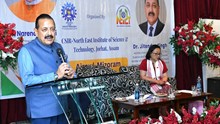
A healthy soil system today is the outcome of a complex network of physical, chemical, and biological soil quality indicators due to the ongoing decline in soil quality. A balance between the requirements of farmers and the community is provided by healthy soils. Toxic substances are deactivated, infections are suppressed, and environmental sustainability is preserved thanks to soil organic matter (SOM).
A sustainable food production system entails interactions between the internal and exterior components of the soil. Since they are in charge of driving numerous biological transformations, as well as distinct pools of carbon (C) and macro- and micronutrients, the effective soil microbes play a crucial role in the creation of soil-plant-microbe interaction. In the soil system, there is a huge diversity of bacteria. Through the breakdown of SOM in the soil system, this article highlights the importance of microorganisms for soil health. Rhizospheric complex knowledge is restricted despite their significance in controlling soil-plant systems, despite the fact that the global understanding of soil microbial dynamics is expanding quickly.
Beneficial Effects of Rhizobacteria
To meet today's agricultural needs and ensure future food security, sustainable agriculture is crucial. Considering that our traditional agricultural practices cannot do so due to a number of issues. To achieve the same, we urgently need to build sustainable and efficient mechanisms. Our need for agriculture can potentially be satisfied by sustainable agriculture in ways that conventional approaches have not been able to. This kind of agriculture practices use unique farming methods that completely utilize environmental resources without endangering them. The use of biological procedures, which are a part of special formation, may be a significant replacement for the void left by conventional approaches. This sort of agriculture is advantageous because it doesn't deplete natural resources or affect the next generation. The roots of plants are colonized by a variety of dense populations of microorganisms, including bacteria, fungus, and Actinomycetes.
These microbes are a collection of naturally occurring good microbes that are used as an inoculant to promote plant growth and development (Ahmad et al. 2008). These bacteria' diverse characteristics appeal to contemporary scientists and decision-makers. These microbial communities also enhance crop quality, soil health, and soil quality. Organic materials, which appear as root exudate, are a major source of microbial attraction and habitat. Rhizobacteria live in the rhizospheric zone of plant roots and respond to root exudates through a chemotactic mechanism. Some bacteria coexist with plants in close proximity and communicate in various ways (Singh et al. 2011).
Through a specific signaling molecule, chemical communication takes place. It may produce root nodules that offer suitable conditions for microorganisms to fix atmospheric molecular nitrogen depending on the compatibility of the plant and the microbes. The microbial community, on the other hand, consists of certain subgroups of microorganisms that have properties that promote plant growth. These bacteria might live in the rhizosphere and aid in plant development. Additionally, soil microbes play a significant role in the sustainability of all ecosystems across a variety of applications. These bacteria control the cycling of nutrients, the dynamics of soil organic matter, and improve the effectiveness of nutrient uptake. Symbionts of bacteria improve the effectiveness of nutrient and water uptake by plants. These microbial relationships also control mineralization, nutrient transport, and decomposition.
Soil Health and Crop Productivity
A crucial biological element for microbial activity is the earth crust. One gram of soil is thought to contain up to ten billion bacterial cells, making it a natural habitat for a variety of microbes. Food security is seriously threatened by declining soil fertility. Microbes in the soil play a variety of roles in regulating soil health and crop productivity. It controlled soil fertility by directly or indirectly altering soil characteristics. Interactions between plants and microbes are crucial to the system of agriculture. This partnership could aid in achieving the goal of sustainable agriculture in the future. Numerous microbiological species, including bacteria, fungus, mosses, and liverwort, were present in the soil. Three types of microbes—bacteria, fungus, and actinomycetes—constitute the majority of the soil's microbial biomass.
Rhizospheric bacteria are among them and are responsible for forming relationships with plants, promoting nutrient uptake, water delivery, and reducing a variety of biotic and abiotic stressors. Microbes control the physical and chemical properties of soil and are a good indicator of biological activity in the soil. All nutrient cycles in soil and plant nutrition depend on microorganisms. Changes in temperature, low water content, anthropogenic activity, and grazing have a negative impact on the diversity of microorganisms in the soil and the soil process. The relationship between soil, roots, and bacteria is rather steady and advantageous. Some microbes have negative impact also in rhizosphere zone and harmful for plant growth and development (Ahmad et al. 2008). Due to intensive cropping and unhealthy effect of fertilizers, this relation declines soil microbial diversity.
Direct Mechanism
1 Nitrogen Fixation: The most important element for plant growth and development is nitrogen (N), which makes up 78 percent of the atmosphere. Biological nitrogen fixation results in ammonia, which is then available to plants even though it is present in molecular form and not directly used by plants. nitrogen-fixing is an oxygen-sensitive enzyme complex called nitrogenase. Nitrogenase enzymes use ATP as an energy source to transform atmospheric nitrogen into ammonia. An essential growth factor that influences plant growth and output is biological nitrogen fixation. Numerous microbial species from diverse genera, including Bacillus, Azospirillum, Pseudomonas, Enterobacter, Flavobacterium, Erwinia, and Rhizobium, are capable of fixing nitrogen (Silva et al. 2016). Symbiotic nitrogen-fixing bacteria and non-symbiotic nitrogen-fixing bacteria are the two types of nitrogen-fixing microbes. Members of the rhizobia family, which form symbiotic associations with leguminous plants, are among the symbiotic nitrogen-fixing bacteria. Azospirillum, Azotobacter, Gluconacetobacter diazotrophicus, and cyanobacteria are some of the non-symbiotic bacteria. Symbiotic associations fix the majority of atmospheric nitrogen, with non-symbiotic associations contributing only a little amount. Some of these bacteria for root nodules with their particular host plant roots play a vital part in plant and microbe communication (Yan et al. 2015).
Numerous stress factors, such as salinity and drought, prevent nodulation and subsequently nitrogen fixation. Microbes can withstand drought and salinity better than host plant. The nitrogenase enzymes that fix nitrogen are extremely sensitive to salt, and their activity is greatly decreased in stressful situations. Through a variety of regulators, soil-dwelling microorganisms can drastically alter plant development and productivity. However, many free-living species are thought to have benefits for plant growth. The environmentally friendly and financially viable alternative to chemical fertilizers is biological nitrogen-fixing.
2 Phosphate Solubilization: The most important micronutrient and element for the growth and development of plants is phosphorus. Phosphate ions, which are found in soil, are how plants absorb phosphorus. Rhizobacteria that promote plant growth (PGPR) are capable of solubilizing phosphate and making it available to plants through mineralization and solubilization. In a natural agricultural system, bacteria that can dissolve phosphorus control the biogeochemical cycle. It is in charge of ensuring that all living things function normally. But the majority of the phosphorus in soil is insoluble and unavailable to plants. In addition to stimulating root growth and physiological processes in both plants and animals, it plays a significant role in sugar transfer. Phosphorus bioavailability to plants is influenced by the surrounding environment, microorganisms, and other plants.
The interaction of plant microorganisms may improve phosphorus mobilization in soil and plant availability. Rhizobacteria that can dissolve phosphate are found everywhere in nature, and the amount of them varies from one soil to another. By creating organic acid and phosphatase, phosphate solubilizing microorganisms (PSM) such bacteria and fungi mobilize phosphate. Numerous bacterial and fungal taxa have been classified as phosphate-solubilizing microorganisms (Yadav et al. 2014). The phosphate-solubilizing bacteria are members of the PGPR and play a significant role in plant development (Naseem and Bano 2014). Phosphorus may become soluble as a result of cations chelating or the pH dropping. Depending on the characteristics of the soil, phosphate-solubilizing microorganisms have different impacts. In phosphorus-deficient conditions, the majority of plants connected with rhizobacteria enhance soil phosphorus uptake. Phosphate solubilizing microorganisms (PSM) are a type of biofertilizer that promotes plant growth and supplies phosphorus to plants in a sustainable manner (Naseem and Bano 2014). This is primarily caused by a drop of pH and the formation of organic acids and acid phosphatase. The pH of the area is reduced when organic acids from PSB are released, and phosphate ions from H+ are also released. Important acids produced by plants include oxalic acid, succinic acid, malic acid, etc. These organic acids compete for soil binding sites and plant-accessible phosphorus. The most effective acid that phosphate-solubilizing microorganisms can make is 2-ketogluconic acid. Many different microorganisms are capable of solubilizing phosphate. As a result, using phosphate-solubilizing microorganisms in agricultural systems may be a viable and affordable option.
3 Siderophore Production: For practically all life forms, iron (Fe) is a primary nutrient that is essential for respiration, photosynthesis, nitrogen fixation, and DNA biosynthesis. Due to its extremely poor solubility, Fe3+, iron is typically unavailable to plants and instead produces hydroxides and oxyhydroxides. Iron is essential for physiological and enzymatic function in almost all living things. Microbes can receive iron from bacteria through the release of the iron chelating chemical siderophore. Siderophore has a high oscillation constant for complexing with iron and is water soluble. Extracellular and intracellular siderophore fall under the same classification as siderophore. Plants acquire the majority of their iron through microbial siderophores. The local environment is a factor in how microorganisms produce siderophore, and microbes have the ability to modify that environment. Iron is more affine to siderophore. The siderophore transports inside the bacterial cell and attaches to iron with ease.

Iron is first transported when a siderophore-iron complex binds to a material membrane. Different transporters are needed to move iron across bacterial membranes. Once inside, ligand exchange decreased the iron-siderophore complex into soluble Fe2+ species by converting the iron (Fe3+) complex on the bacterial membrane. Transport of the siderophore-iron complex involves the ABC transporter (ATP-binding cassette) (Babu et al. 2013) The plant can either directly absorb the iron from the bacterial siderophore or use a ligand change process to integrate the iron. The amount of chlorophyll a and chlorophyll b in plant leaves is one of the main effects of siderophore-iron. A novel siderophore produced by Pseudoalteromonas piscicida S2040 called pseudochelin A has siderophore action against Aspergillus fumigatus.
Indirect Mechanism of Plant Growth Promotion
The indirect effect of bacteria that promote plant growth happens when they either lessen or prevent the harmful effects of pathogens through a variety of processes. Biocontrol is the process of using microorganisms to treat plant diseases (Kasim et al. 2013). It is a method for lessening the harmful effects of viruses that is both economical and environmentally sustainable. Rhizobacteria secrete a variety of antifungal and antibacterial agents that aid in disease resistance. Competition for nutrients, antifungal metabolites, induced systemic resistance (ISR), and niche exclusion are among the main indirect effects. Numerous metabolites secreted by rhizobacteria, including 2,4-diacetylphloroglucinol, HCN, phenazines, and pyrrolnitrin, are significant biocontrolling agents.
1 Plant Growth Stress Condition: The productivity of agriculture is a key global concern due to climate change. The agricultural system will suffer from the effects of climate change. Plants are adversely affected by stress either directly or indirectly. For instance, drought conditions cause increased ethylene synthesis, impede photosynthesis, harm the photosynthesis machinery, and reduce chlorophyll levels. Similar to this, salinity raises ion concentration, particularly ions that harm plant growth and development. Additionally, the general impact of bacteria alters the physiology of plants and creates hormonal and nutritional imbalances. There are numerous microbial genera that have been found to be able to thrive in stressful environments and increase crop output ( Hashem et al. 2016). Microbes can find a home in the soil, which is a dynamic and complicated system. The development of microorganisms in soil is influenced by soil conditions and how they affect plants. PGPM is beneficial in reducing environmental stress conditions like heat stress, salinity stress, and drought stress, among others. These bacteria employ a variety of strategies to lessen undesirable effects. Ion toxicity brought on by salinity is countered by the use of PGPR, which lowers the quantity of ethylene.
2 Mycorrhizae: Mycorrhizae are a type of interaction between fungus and the roots of higher plants. In agricultural fields, arbuscular mycorrhizae (AM) are the most prevalent fungi. The relationship between higher plants and fungus is about 80%. It is important for the cycling of nutrients in agricultural fields. Mycorrhizae are crucial for maintaining the availability of nutrients to plants, enhancing the physical characteristics of soil, and aiding in soil aggregation (Garg and Pandey 2016).
Under stressful conditions, mycorrhizae create a variety of metabolites, including amino acids, vitamins, phytohormones, and mineralization. There should be an impact on rhizospheric microorganisms, soil types, nutrients, moisture content, and temperature as a result of the interaction between PGPR and mycorrhizae fungi. Additionally, this association's cumulative impacts help plants grow and develop both normally and under stress. Furthermore, according to some studies, under stressful conditions, mycorrhizal fungi also have an impact on a plant's physiology through an osmoregulator. Osmoregulation, including proline synthesis, water utilization efficiency, and carbon dioxide exchange, are all part of this process. Under dry conditions, it also improves sugar and electrolyte concentration. Mycorrhizal function changes depending on the sort of stress. For instance, variations in Na+ and K+ uptake under salt stress and nitrogen availability during droughts (Kang et al. 2016).
3 PGPR and Sustainable Agriculture: Our traditional agriculture will need to undergo a profound change to become sustainable. Microbes that promote plant growth (PGP) are thought of as an alternative to traditional agricultural methods. Rhizobacteria that promote plant development Kloepper and Schroth (1978) initially identified plant growth-promoting rhizobacteria (PGPR) as bacteria that colonize plant roots upon inoculation and promote plant growth and development. A variety of microorganisms, including those that fix nitrogen (Peix et al. 2015) and solubilize phosphate (PGPR), are vital to the soil microbiota that supports plant growth and development. These microorganisms collaborate to establish nodule-forming associations. These bacteria promote soil nutrient availability, the creation of plant growth regulators, the regulation of plant growth characteristics, and soil health to promote plant growth and development. Depending on how plant bacteria interact, biofertilizer can have a neutral, positive, or negative impact on producing crops in various climate regions. Microbes that successfully colonized the plant promote plant growth by giving it both major and minor nutrients. Biological nitrogen fixation, phosphate solubilization, and potassium are also involved in this relationship; these processes aid in the growth and development of plants. For the development of their shoots and roots, plants need phytohormones like indole acetic acid (IAA), gibberellin, and cytokine. These hormones are responsible for various stages of plant growth and development. IAA, for instance, has an impact on plant tissue differentiation and root formation. Due to the increased surface area, IAA-induced root development and improved root hair formation aid in water and nutrient absorption. This led to significant growth and great crop yield. Gibberellins have a crucial role in controlling plant growth by influencing seed germination, stem development, flowering, and fruit setting. Additionally, it reduces ethylene production and controls ethylene levels under stressful conditions by producing 1-aminocyclopropane-1-carboxylate (ACC) deaminase (Saleem et al. 2007; Glick 2014).
REFERENCES
Ahmad F, Ahmad I, Khan MS (2008) Screening of free-living rhizospheric bacteria for their multiple plant growth promoting activities. Microbiol Res 163(2):173–181
Babu AG, Kim JD, Oh BT (2013) Enhancement of heavy metal phytoremediation by Alnus firma with endophytic Bacillus thuringiensis GDB-1. J Hazard Mater 250:477–483
Garg N, Pandey R (2016) High effectiveness of exotic arbuscular mycorrhizal fungi is reflected in improved rhizobial symbiosis and trehalose turnover in Cajanus cajan genotypes grown under salinity stress. Fungal Ecol 21:57–67
Glick BR (2014) Bacteria with ACC deaminase can promote plant growth and help to feed the world. Microbiol Res 169(1):30–39
Hashem A, Abd-Allah EF, Alqarawi AA, Al Huqail AA, Egamberdieva D, Wirth S (2016) Alleviation of cadmium stress in Solanum lycopersicum L. by arbuscular mycorrhizal fungi via induction of acquired systemic tolerance. Saudi J Biol Sci 23(2):272–281
Kang Y, Hao Y, Shen M, Zhao Q, Li Q, Hu J (2016) Impacts of supplementing chemical fertilizers with organic fertilizers manufactured using pig manure as a substrate on the spread of tetracycline resistance genes in soil. Ecotoxicol Environ Saf 130:279–288
Kasim WA, Osman ME, Omar MN, Abd El-Daim IA, Bejai S, Meijer J (2013) Control of drought stress in wheat using plant-growth-promoting bacteria. J Plant Growth Regul:1–9
Naseem H, Bano A (2014) Role of plant growth-promoting rhizobacteria and their exopolysaccharide in drought tolerance of maize. J Plant Interact 9(1):689–701
Peix A, Ramírez-Bahena MH, Velázquez E, Bedmar EJ (2015) Bacterial associations with legumes. Crit Rev Plant Sci 34(1–3):17–42
Saleem M, Arshad M, Hussain S, Bhatti AS (2007) Perspective of plant growth promoting rhizobacteria (PGPR) containing ACC deaminase in stress agriculture. J Ind Microbiol Biotechnol 34(10):635–648
Silva WO, Stamford NP, Silva EV, Santos CE, Freitas ADS, Silva MV (2016) The impact of biofertilizers with diazotrophic bacteria and fungi chitosan on melon characteristics and nutrient uptake as an alternative for conventional fertilizers. Sci Hortic 209:236–240
Singh JS, Pandey VC, Singh DP (2011) Efficient soil microorganisms: a new dimension for sustainable agriculture and environmental development. Agr Ecosyst Environ 140(3):339–353
Yadav J, Verma JP, Jaiswal DK, Kumar A (2014) Evaluation of PGPR and different concentration of phosphorus level on plant growth, yield and nutrient content of rice (Oryza sativa). Ecol Eng 62:123–128
Authors
Sandip Kumar Gautam, Kautilya Chaudhary, Anil Kumar
Department of Soil Science, CSJM University, Kanpur Nagar, UP (209202)












Share your comments